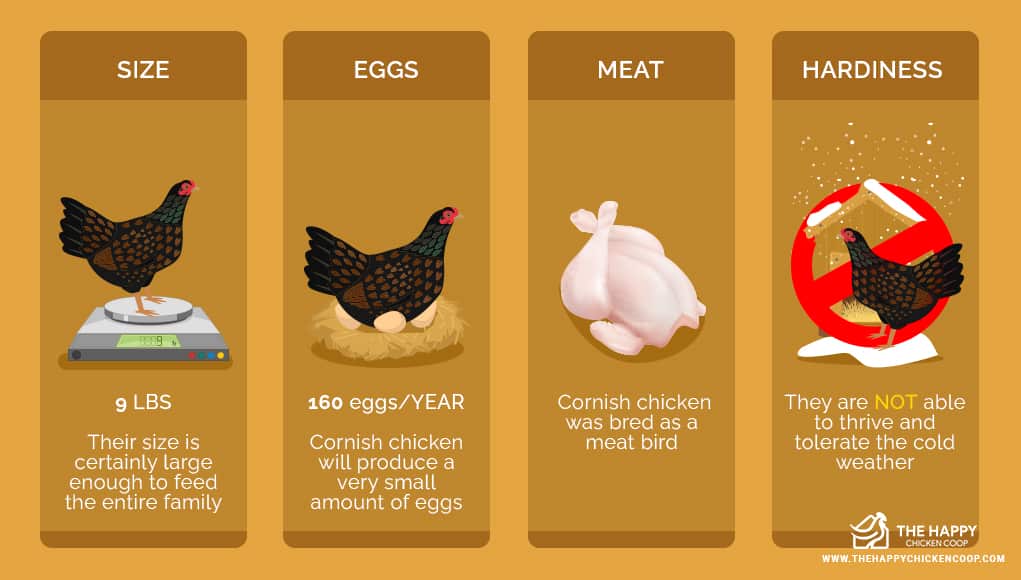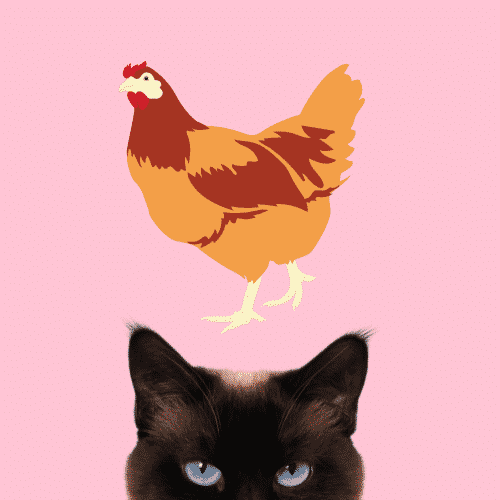When it comes to eating cornish chickens, some people question whether or not cats are capable of eating them.

These are the topics that will be discussed in this post, as well as suggestions on how often and how much to feed a cat cornish hen.
What Are Cornish Hens?

It’s common in the United States to find Cornish chickens, a small breed of fowl. The county of Cornwall, England, is where they got their start and where they got their name.
As a general rule, though, Cornish chickens aren’t considered to be among the most beautiful birds in the poultry world.
Despite their friendly demeanor, Cornish chickens have an intimidating appearance. It’s as if they have razor-sharp eyes and the features of an angry chicken, a mad wet hen, to put it another way.
In some ways, this is a reflection of their temperaments. A little background on their history shows that they were originally bred for hunting purposes.
Can Cats Eat Cornish Hens?
Cornish hens may be okay for cats to eat, but some people aren’t sure about it.
The cat’s age and health, as well as the hen’s size and weight, all, have a role in the answer to this query.
Cornish hens can be fed to cats as long as they are small enough to be eaten whole, which is generally the case.
But first, make sure your cat isn’t allergic to cornish chickens or poultry in general by consulting your veterinarian.
Are There Any Dangers to Feeding Cornish Hens to Cats?
Chocking is the most common problem when giving cat food to a cornish hen.
If the bird is not sliced into little pieces before being fed to the cat, this is especially true.
Cornish hens may also have bacteria that can cause food poisoning in cats, which is another cause for concern.
Before feeding cornish hens to cats, be sure to consult a veterinarian and cut the birds into small, bite-sized pieces to avoid these dangers.
How Much Should You Feed a Cat Cornish Hen?
Both the bird’s and the cat’s size and weight influence how much cornish hen to feed. In general, a piece no larger than an inch square should be used as a starting point.
It is possible to gradually raise the serving size of cornish chickens to roughly two ounces for cats that like them.
How Often Can You Feed a Cat Cornish Hens?
Depending on how much your cat consumes, you can feed it cornish hens once or twice a week. Overfeeding the cat might lead to obesity and other health issues.
Best Raw Bones For Cats – UPDATED 2022
So here is a list of bones adapted for a cat:
- Quail bones (all can be fed)
- Rabbit ribs
- Coquelet (young chicken), any parts
- Chicken neck
- Small chicken wings
- Rabbit front legs
- Chicken feet
- Chicken back
- Small duck neck
It is recommended either quail bones or rabbit ribs for a cat who is new to raw feeding. Bones should be fed in a variety of forms, much like meat.
Chicken necks can cause hyperthyroidism if they are the only food given to a dog. Néline eats dove bones, rabbit bones, and chicken necks as an illustration of what she consumes.
Raw Meaty Bones for Cats – What You Should Know?
Bones need to be:
- Raw: Bones that have been boiled or dehydrated can splinter if fed! Freeze-dried bones should also be avoided as a precaution.
- When there’s plenty of meat to go around. Unprotected bones can be deadly.
- Tolerated the cat’s extra bulk. If a cat tries to eat a bone that’s too large, it could injure itself by biting into it.
- Uncut, with the exception of a joint-level cut in two different bones
Harmful Risk of Bones
When it comes to feeding bones, it may sound like something out of a horror movie. Wild cats, on the other hand, are mostly focused on preying on small mammals like mice and birds. They regularly consume them, bones and all, because this is their normal diet.
Nonetheless, there is no such thing as a risk-free situation. As a result, you should always keep an eye on your pet if it appears to be chewing on bones.
Remember that overfeeding bones can lead to constipation and even an occlusion, so be careful.
Feeding Cats Raw Chicken Wings – Is It Safe?
In comparison to huge and firm marrow bones, chicken wings have smaller bones.
Feline choking risk is not posed by the softer bones of chicken wings and necks, which are easier for cats to chew and swallow.
Additionally, little bones are less likely to become clogged in your pet’s digestive tract, which means that your cat will be able to digest them more easily.
However, if you intend to feed your cat huge bones, such as marrow bones, it is usually suggested that you reconsider your choice.
Here are a few reasons why your cat’s huge and hard bones cause danger.
- Large bones provide a choking hazard for cats.
- Marrow bones have larger outer rims, which might cause your cat’s teeth to break or crack.
- A cat’s gums can be punctured by huge bones if they are compressed, just like a human’s.
Cats should not be fed large amounts of bone even if they are little.
- Why Do Cats Sit on Laptops?
Other Healthy Raw Organs for Cats
For both people and animals, organ meats provide a wide range of health benefits. Organ meats have been compared by experts to cat superfoods. Compared to muscle meat, they are a good source of essential vitamins and minerals.
Cats who are elderly or ill benefit greatly from the consumption of organ meats. Cats who have lost their appetite may be drawn to the pungent smell of organ meats, which can provide them with a nutrient-dense alternative to conventional meat.
Hearts
Taurin, a cat-essential amino acid, is prevalent in the hearts of cats. A cat’s risk of tooth decay, heart disease, and vision loss due to retinal degeneration can be reduced if taurine levels are adequate. There are high levels of CoQ10, an important antioxidant for the brain and cardiovascular system. Collagen, which is abundant in the hearts, also aids with joint health.
Tripe
Herbivorous hoofed animals such as cows and sheep produce tripe, which is the lining of their stomach. A wide range of benefits for cats can be found in tripe, particularly unprocessed green tripe. Probiotics are essential for a healthy digestive tract in cats. Tripe’s nutritional value is preserved when served raw. To learn more about raw diets for cats, check and read our guide.
Kidneys
The kidneys have a broad list of vitamins and minerals. Among the many nutrients found in these protein-rich organs are vitamins A, C, and D, as well as calcium, iron, and riboflavin. A considerable amount of folate, which is essential for DNA synthesis, is found in the kidneys, as well.
Liver
Protein and vitamins are also abundant in cat liver. Cupro, which cats require for the development of blood cells and other tissues, is also found in the liver. The liver is heavy in fat, thus it should be consumed in moderation, especially for overweight cats.
Toxin-filtering properties of liver and kidney meat have led some pet parents to avoid eating them. Toxin levels in kidneys and livers are comparable to those seen in muscle meat, according to specialists. In addition, eating organ meat from a grass-fed animal can further reduce the meat’s toxins.
Are There Any Risks to Feeding Your Cat Organ Meat?
Organ meat is another case in which there is such a thing as having too much of a good thing. Some felines’ stomachs may be upset as a result of consuming too many organs.

In the same way, giving your cat a diet heavy in animal hearts can lead to elevated blood pressure over time. Vitamin A poisoning in cats is another side effect of having an excessive amount of liver. As a result, no more than 5% of a cat’s daily calorie intake should come from the liver.
Choosing Organ Meat for Your Cat
If you wish to offer your cat raw organ meat, you need to make sure it’s of the highest quality. When buying organ meat for your cat, look for the following characteristics:
- In date
- Fresh or freeze-dried
- Organic
- Grass-fed or vegetarian diet-fed
What Are the Benefits of Feeding a Cat a Cornish Hen?
Cornish hens are a significant source of protein, as well as vitamins A and B12, which are important for overall health.
Cornish hens can help a cat maintain a healthy appetite and a healthy weight by promoting a healthy diet.
Cornish hens can also aid in the health of a cat’s coat and skin.
Cornish hens should be fed to cats in little pieces no more than an inch square.
If the cat likes cornish hens, you can gradually raise the amount of the serving until it reaches roughly two ounces.
Depending on how much your cat consumes, you can feed it cornish hens once or twice a week. Overfeeding the cat can lead to obesity and other health issues, so be careful.
- Can Cats Eat Dragon Fruit? What You Need to Know About This Exotic Fruit
Can Cats Eat Cornish Hens? The Bottom Line
YES! Cornish hens are a significant source of protein, as well as vitamins A and B12, which are important for overall health.
Cornish hens can help a cat maintain a healthy appetite and a healthy weight by promoting a healthy diet. Cornish hens can also aid in the health of a cat’s coat and skin.

Doctor of Veterinary Medicine (D.V.M.) at Nation Taiwan University,Master of Science (M.S.) in Biomedical Engineering at National Taiwan University of Science and Technology




